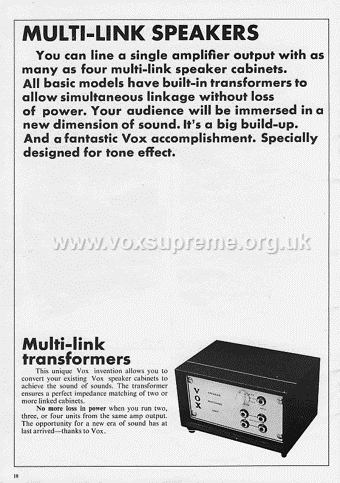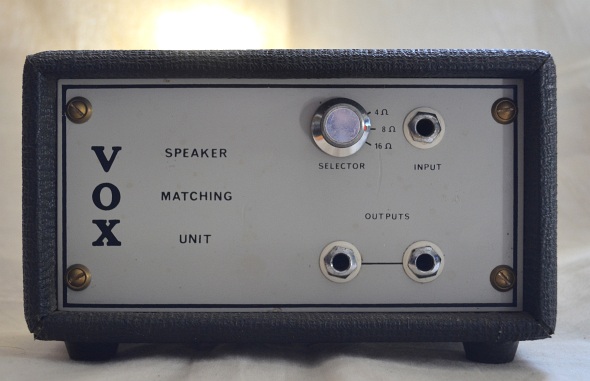The Vox Multi Link Transformer - impedance matcher
Click for larger images.
Above, Multi Link speaker cabinets in the Vox Sound Equipment Limited (VSEL) brochure of early 1969. The text reads:
"This unique VOX invention allows you to convert your existing VOX speaker cabinets to achieve the sound of sounds. The transformer ensures a perfect impedance matching of two of more linked cabinets. No more loss in volume when you run two, three or four units from the same amp output. The opportunity for a new era of sound has at last arrived - thanks to VOX.".
The transformer was incorporated as standard in the Multi Link I and II cabs. One could also buy it separately.
The intention was to make the solid state amps, which only had only speaker output socket, more versatile.
The transformer in the Vox Sound Limited (VSL) catalogue of August 1970. The blurb surrounding it is the same as in the VSEL advert.
Note that the free-standing transformers pictured in the adverts have four outputs. Units incorporated in the speaker cabs generally only have two.
Information plates were affixed to indicate what the total impedance of numbers of linked cabs should be. The sum impedance is switchable between 4, 8 and 16 ohms.
A surviving Multi Link transformer - currently in the UK
This unit probably came from a Multi Link speaker cabinet as the tolex is a bit rough and ready - no point taking too much effort if it was not to be seen. Two speaker outputs are provided.
Below, the two principal styles of information plate on Vox Multi-Link speaker cabinets. The first (VSEL) is far clearer than the second (VSL). That said, it is far from perfect. The two cabs bearing the plates both have impedance matching units that allow two further cabs to be attached. It is important to bear in mind the fact that the Multi-link cabs are themselves 15ohm units:
The matcher is straightforward. The INPUT connects the output of a Vox solid state amp (all of which require a 15ohm load) via the matching transformer to the speakers in the ML cabinet. The four speakers in the ML are wired up so as to give a 15ohm impedance. The two OUTPUT sockets are for further speaker cabinets.
The "Vox Sound Equipment Limited" information plate (above) is relatively straightforward. Set the selector to 15ohms when using the ML on its own. Use the 8ohm setting if a further 15ohm cab is plugged in; set to 4ohms when two 15ohm cabs are attached. No advice is given however on how to connect up four 15ohm cabs (ie. the ML and three additional units). A four cab link up is only really possible with a Vox matching unit that had four outputs (some did, but not the one accompanying this plate).
The setting for a single 8ohm cab only makes sense if the ML itself has an 8ohm impedance (not possible with the speakers fitted by Vox). The 4ohm setting is fine for two speaker cabinets of 8ohms, but the means of achieving that is not specified.
The 4ohm setting envisages a single 4ohm cab - which only makes sense, as above, if the ML cabinet is rewired internally for that impedance (which is possible using the speakers fitted by Vox).
The VSL plate gives the impedance required by the amplifier in the first column, and the setting of the matcher in the second.
The first row gives the setting for the ML cab itself, no other attached: - 15ohms
The second row gives the setting for the ML cab + one further 15ohm cab: - 8ohms
The third row gives the setting for the ML cab + two further 15ohm cabs: - 8ohms, which differs from the recommendation on the VSEL plate.
The last row gives the setting for the ML cab + three further 15ohm cabs: - 4ohms, though it does not explain how the third of the extra cabs is to be hooked up. The matching unit only has two output sockets.
All well and good if the user is clued up and the impedances of the additional cabinets are known. Vox was clearly sailing with a good deal of hope.











